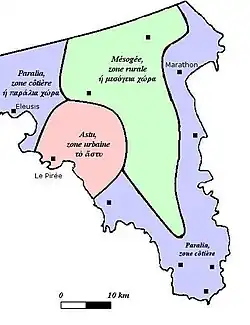Asty

Asty (Greek: ἄστυ; Ancient Greek: [ásty]) was the physical space of a city or town in Ancient Greece, especially as opposed to the political concept of a polis, which encompassed the entire territory and citizen body of a city-state.[1]
In Classical Athens, the asty was specifically the urban demoi of Attica, as opposed to the inland (mesogeia) and coastal (paralia) demoi that comprised each of the ten Attic tribes.[1] Despite their name, most of the demoi of the asty were rural in character.[1] Comprising about 42 of the 139 demoi of the Athenian state, they provided about 130 bouleutai in the 500-strong boule.[1] However, due to their proximity to the city of Athens, they were over-represented in the institutions of the Athenian democracy; in surviving records, the names of the bouleutai from the asty are mentioned 1.5 to 2 times as often as those from the rest of Attica.[1]
Asty Demoi
Asty demoi located within Athens inside the Themistoclean Wall:
Asty demoi located Within Athens outside the Themistoclean Wall:
- Ankyle (Upper & Lower)
- Agryle (Upper & Lower)
- Alopece
- Butadae
- Cerameis
- Ceriadae
- Daedalidae
- Diomea
- Laciadae
- Piraeus
- Xypete
Asty demoi located outside Athens:
Unlocated asty demoi: